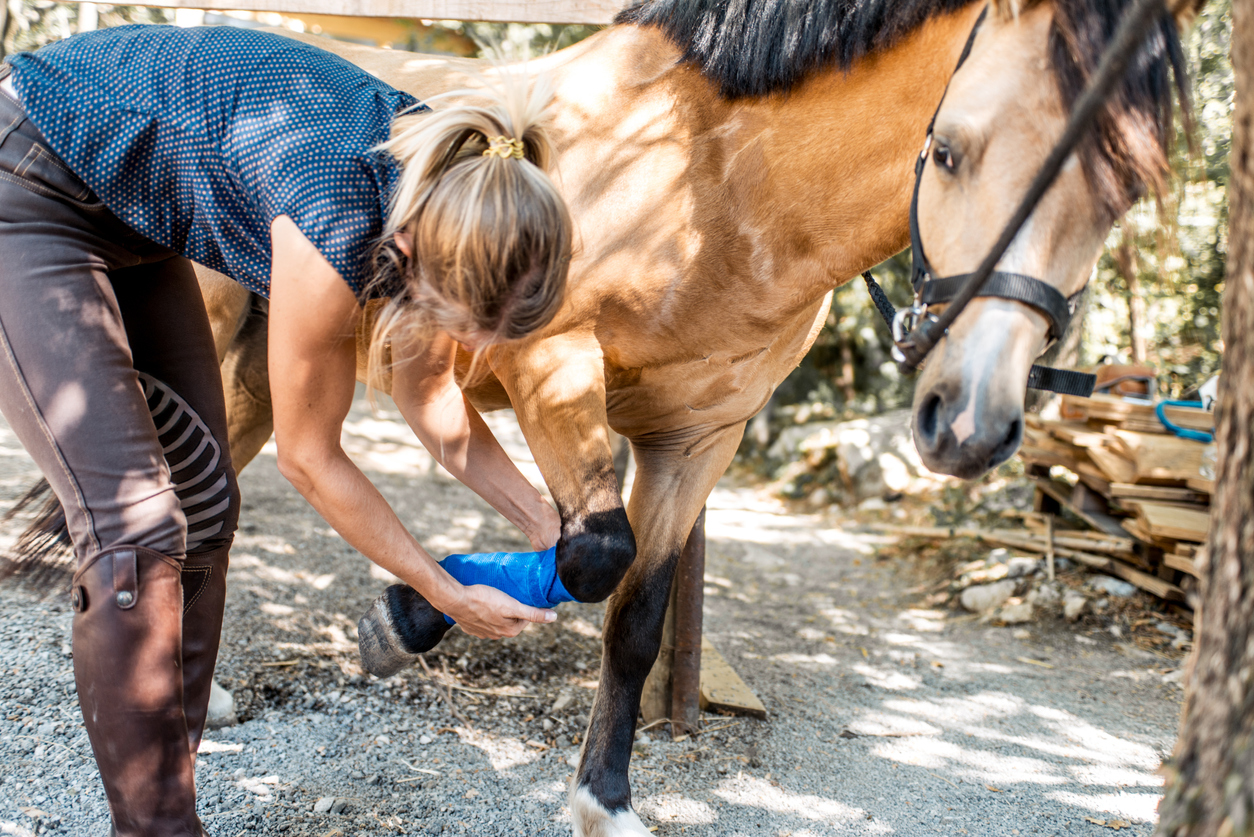Table of Contents
You’ve probably heard of cats being curious, but horses can give their feline friends a run for their money! Horses are naturally very curious, which can get them into a lot of trouble. This curiosity can also result in injuries.
Sometimes, horses can get injured enough that they need effective wound care to heal properly. There are many reasons why a horse could end up with an open wound, including coming into contact with an animal, snagging themselves on a fence, or miscalculating a jump and landing awkwardly on a piece of equipment.
Because of the many ways that a horse can end up with an open wound, it’s important that horse owners understand basic horse wound care. This includes knowing which techniques and products to utilize and how to control bleeding and prevent infections from occurring.
In this article, we explore basic horse wound care, different horse wound care products, treatment options, potential complications that can occur (and how to deal with them), and preventative measures that you can take to help avoid your horse getting injured in the first place.
Basic Horse Wound Care
As a horse owner, it’s important to learn some basic horse first aid steps so that if your horse gets injured, you can act appropriately. Here are some steps to basic horse wound care:
- Stay calm. Your horse will feed off of your energy. If you’re calm and collected while trying to catch your horse, there is a better chance that they will also remain calm.
- Guide them to a quiet area or a clean, dry stall. You’ll want a safe area like a horse stable to tend to your horse’s wound. Using a feed bucket is a good idea to entice your horse to come where you want them to.
- If you have help available, use it. An extra set of hands is always welcome when dealing with a wounded horse. One person can help keep the horse calm while the other examines the wound and administers treatment.
- Rinse the wound with saline solution or clean, cold water. Rinsing the wound will help you identify the location of the wound and remove contaminants. Cold water can also assist with reducing swelling.
- Stop the bleeding by applying pressure to the wound. Apply direct pressure to the wound using a sterile bandage, such as gauze. If the wound bleeds through the bandage, apply a new one on top without removing the old bandage. Doing so helps prevent you from accidentally removing blood clots that have formed under the material.
- Once bleeding has been controlled, it’s time to assess the wound. Determining the wound's location, depth, and overall severity is important. A wound that bleeds a lot may not accurately indicate how severe it is, so it’s important to get a clear view. In addition, some large wounds may heal better than smaller ones, depending on the area of your horse’s body they’re on. Take pictures of the wound and contact your veterinarian for more advice and information on proper horse wound care.
Horse Wound Care Products
Caring for your horse’s wounds is generally easy, provided they are minor. Most veterinarians recommend using a simple saline solution to start with, as it won’t break down the skin and cause additional tissue damage. Sterile saline solution can be purchased from your veterinarian or from some farm supply stores. You can also make your own saline solution by dissolving two tablespoons (about 28 g) of regular table salt in 1 gallon of distilled water (about 4 litres). Saline is useful to have on hand to flush the wound to remove dirt and debris, which is sometimes all that is needed to assist your horse in healing. Keep in mind that flushing should be done after the bleeding has subsided.
After flushing, you may want to apply other products to the wound depending on the severity:
|
Horse Wound Care Product |
Importance/Use Case |
|
An antiseptic scrub or solution containing chlorhexidine, povidone iodine, or betadine. |
Keep in mind that there is a difference between a solution versus a scrub. Scrubs may not be recommended in all cases because the act combined with the strong antiseptic can further damage wounded tissue. It’s best to consult your veterinarian for advice on how to properly clean a specific wound. Using rubber gloves with these types of products is also recommended. |
|
Antiseptic cream or gel |
Helps prevent infection and stays longer than a spray or solution. Do not apply antiseptic cream or gel if bone is exposed or on an open wound on a joint. |
|
Bandages |
Important to keep the wound clean and protected while it heals. Typically, horse bandages have three layers: a primary non-stick layer that is placed directly on the wound, a secondary padded layer, and a top layer that holds everything in place and provides some level of compression. |
Horse Wound Infection Treatment
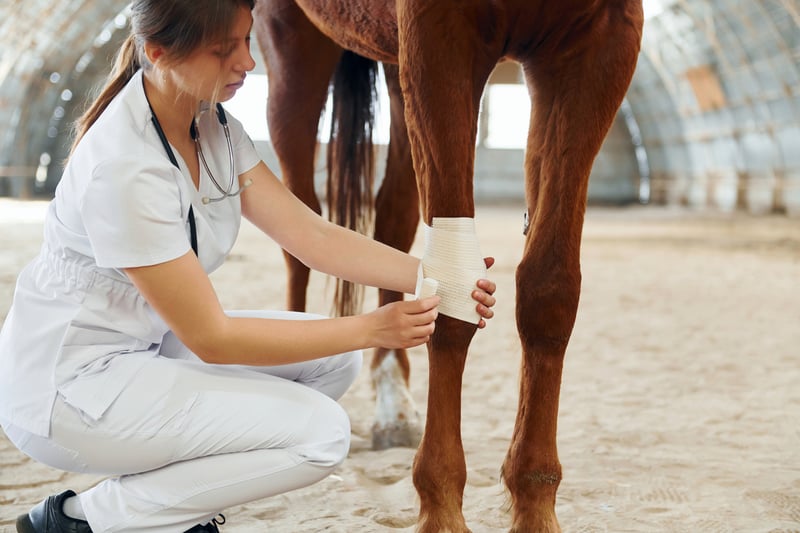
Anytime a horse gains an injury resulting in a wound, there is a chance that the wound can become infected. Appropriate initial management of the wound is important since if the wound is tended to properly, the chance of infection is greatly reduced. However, some types of injuries, such as penetrating joint or tendon injuries have a greater chance of getting an infection even with proper care.
To treat a horse wound infection properly, it’s important to seek the help of a veterinarian. A vet may trim dead or unnecessary skin, remove dirt and foreign particles that may have been missed, clean the wound with saline and/or the appropriate antiseptic solution or scrub, and suture the area if needed. They may also prescribe oral or topical antibiotics as well as pain relief for your horse.
General steps for avoiding an infection include:
- Keeping the wound clean (includes flushing the wound and removing dirt and debris)
- Keeping the wound protected from the elements with an appropriate bandage or wrap
- Using an antiseptic solution, spray, gel, or cream (under the advice of a vet)
Using TRI-ACTA to Aid in Horse Wound Recovery
A great addition to help your horse recover from an infection, wound, or surgery is using TRI-ACTA or TRI-ACTA H.A (the latter is our extra-strength product that includes hyaluronic acid, which thickens the synovial fluid in the joints, enabling easier movement). Both of these mobility joint supplements contain a natural anti-inflammatory called Methylsulfonylmethane (MSM), which helps reduce inflammation, especially if the injury is in one of your horse’s joints.
TRI-ACTA H.A. for Equine
Our maximum strength formula is perfect for horses that are ageing, experiencing arthritis and stiffness, are in training and competition, or under a heavy workload.
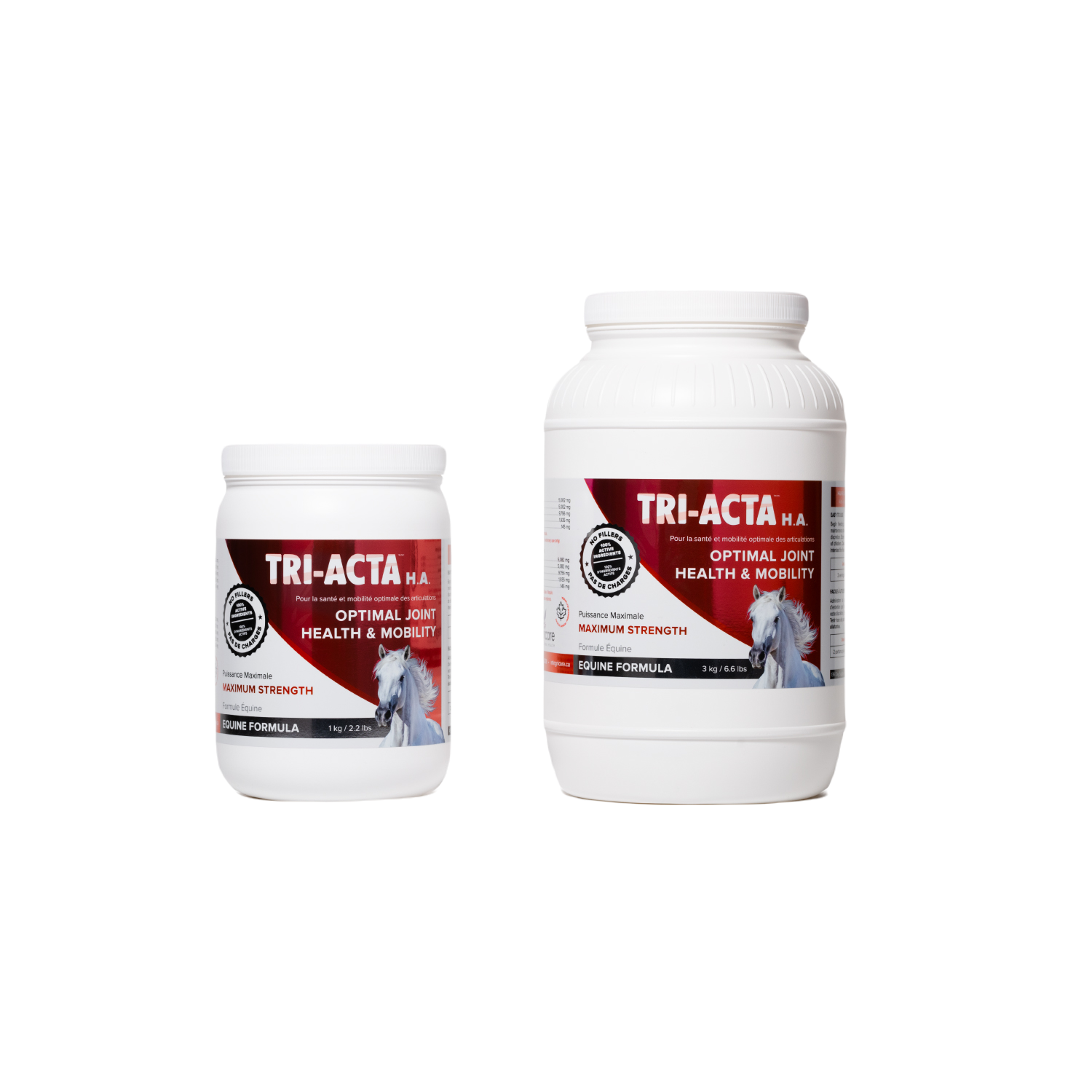
Recommended Horse Wound Care Spray
Sprays are a great tool in your horse wound care arsenal. Horse wound care sprays assist with healing by keeping the wound moisturized and soothing itchiness, irritation, swelling, and tightness.
Typically, there are two types of horse wound care spray—cleansing spray and a barrier-type spray that helps prevent dirt and debris from entering the wound once cleaned.
Keeping that in mind, here are our recommendations:
1. PuriShield Wound & Skin Care Fast-Acting Wound Spray
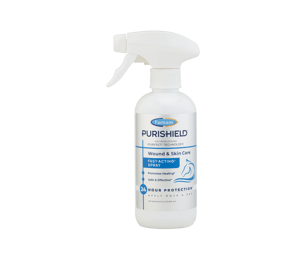
Farnam Purishield is a fast-acting horse wound care spray that can be used in any type of minor or major wound care plan, including cuts, burns, post-surgical sites, sores, abrasions, and more. To use, clean the wound thoroughly first with saline or cold water, and then apply the product. You only need to apply it once every 24 hours. It’s important to keep the wound clean and protected during the healing process.
$36.05 CAD for a 12oz (about 354 ml) bottle. Pricing as of January 2024.
2. Aluspray Aerosol Bandage
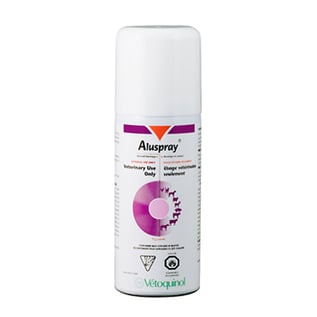
Aluspray is an aluminum-based horse wound spray that when used, forms a protective, weather-resistant barrier for wounds and sensitive skin. It helps prevent infection from moisture, microorganisms (including bacteria and fungi), dirt, and insects. For horses with a wound on their backside, this product protects the wound or sensitive skin from diarrhea and post-castration. A spray-on product like Aluspray is a great option for horse wound care, especially in areas where applying a bandage properly is difficult.
$25.00 CAD for one bottle. Pricing as of January 2024.
Benefits of Equine Wound Care Products

Using equine wound care products has many benefits to making wound care easier and more effective for your horse, as well as promoting healing, preventing infection, and overall aiding in recovery. The benefits of horse wound care products include:
1. Reducing the Chances of Infection and Scaring
Equine wound care products often contain antiseptic and/or antimicrobial ingredients that help prevent bacterial and fungal growth. They can also form a protective barrier, which helps prevent contaminants from entering the wound after it has been cleaned.
2. Promotion of Healing
Horse wound care products assist the horse’s body’s natural healing process through ingredients like collagen that encourage tissue regeneration and overall faster recovery. Proper wound care can minimize scarring by supporting the formation of healthy tissue and minimizing tissue damage.
3. Provides Pain Relief
Most horse wound care products contain analgesic (painkilling) properties that help alleviate pain and discomfort for your horse while the wound heals. When your horse is more comfortable during the healing process, they produce less of the stress hormone cortisol and can heal faster as a result.
4. Protection from the Elements
Barrier-type horse wound care products are excellent for keeping out dirt, dust, debris, and insects from the wound that could hinder the healing process and cause irritation or infection. Barrier wound care products are also great to use for areas that are difficult or impossible to bandage to add an extra layer of protection.
5. Easy Application
Horse wound care products are designed to be easy to apply and manage. Sprays, gels, creams, and dressings give horse owners options for treating their wounds, and the ease of application means that consistent and effective care can be provided without a lot of effort.
What to Look For in Horse Wound Care Supplies
When selecting horse wound care products, several factors should be considered to ensure you're choosing the most suitable option for your horse's specific injury. Here's what to look for:
1. Severity of the Wound
Identify the nature and severity of the wound. Different products are designed for various wounds—cuts, abrasions, punctures, or surgical incisions. Choose a product tailored to the specific type of injury.
2. Ingredients
Check the ingredients list for antiseptic or antimicrobial properties that prevent infections. Look for components like silver sulfadiazine, chlorhexidine, or iodine, known for their antimicrobial effects. If your horse has any allergies or sensitivities, be sure to keep those in mind when selecting an appropriate product.
3. Ease of Application
Choose products that are easy to apply and manage, especially if the wound is in an area that's challenging to access or requires frequent application. Depending on the wound and its severity, you may want to go with a cream, spray, or gel. Sprays are typically the easiest to administer but may be difficult to effectively cover the whole area. Creams and gels may need to be applied more often but can offer better coverage.
4. Veterinary Recommendation
Consult with a veterinarian or equine healthcare professional for recommendations. They can suggest specific products or ingredients based on the wound's condition. You can also choose a few different products and ask your veterinarian for their opinion on them and their appropriateness for your horse’s wound care.
Horse Open Wound Care Complications
Just like with any injury, potential complications can arise when your horse gets a wound. Sometimes you can do everything correctly in terms of addressing the wound and ensuring a consistent level of care for your horse, but complications can still happen. It’s important to recognize the signs of a horse wound complication so that you can address it as soon as possible.
Some potential complications that can happen during the horse wound care process include:
- Wound dehiscence. This is when the edges of the horse’s wound that were once healing together come undone, usually by a failure of the sutures used to hold the wound together. Wound dehiscence can be caused by the wound being in a heavily muscled area of the horse’s body, especially on the lower limbs, by the horse rubbing up against equipment or something in their environment, infection, or general trauma to the area from the environment. In some cases, a veterinarian may instruct to leave the wound open instead of suturing it again.
- Infection. Any wound can get infected, even with proper care. If your horse has an underlying condition such as diabetes or immunodeficiency, the chances of infection increase. A vet may prescribe oral or topical antibiotics to help treat the infection.
- Sequestra formation. In some cases, an infected piece of bone such as a splinter can cause your horse’s body to think it’s a foreign object and prevent the wound from healing. Sequestria can form when the blood supply to the bone is damaged or disrupted (hence a splinter) and can sometimes be difficult to identify, especially when the offending bone is small. The typical course of action is removing and treating the infection with antibiotics.
Wound Care Horse Prevention
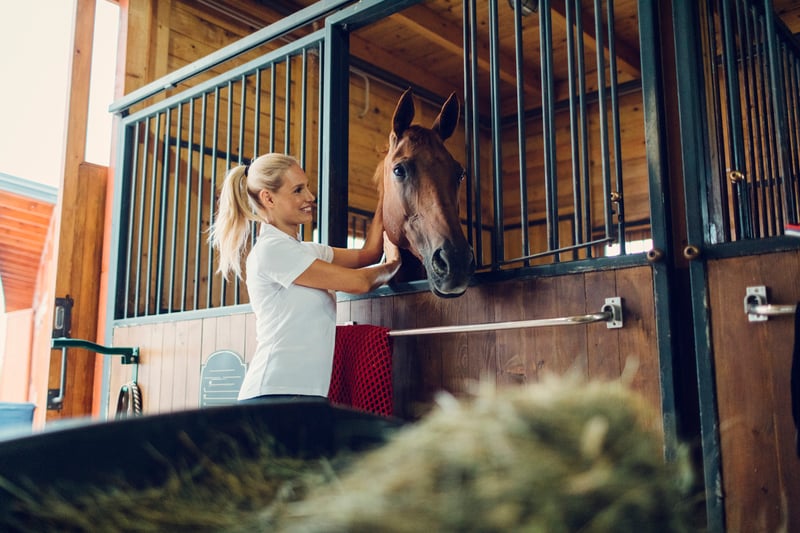
Preventing horse wounds is a critical aspect of equine care, as it not only ensures the horse's well-being but also reduces the need for extensive horse wound care treatments. Here are some preventive measures that you can follow:
- Ensure a safe environment. Regularly inspect the horse's living area, pasture, or stable for potential hazards such as sharp objects, protruding nails, broken fences, or rough surfaces. Remove or repair any hazards to minimize the risk of injury.
- Maintain hoof health. Regular hoof care, including trimming and cleaning, can prevent lameness issues that might lead to injuries from uneven terrain or overgrown hooves.
- Invest in preventative care for your horse’s skin and coat. Maintain proper grooming routines to keep the skin and coat healthy. Regular grooming removes dirt and debris, preventing skin issues that could lead to wounds.
- Keep a first aid kit. A well-stocked equine first aid kit is important so you can give prompt attention to minor wounds. Tending to minor wounds or cuts can prevent them from escalating into more severe issues.
- Use a joint supplement like TRI-ACTA. Incorporating a daily joint supplement into your horse’s diet can go a long way in helping them recover from injuries faster. Joint injuries in horses are one of the most common, and TRI-ACTA helps strengthen their joints with a combination of glucosamine (supports overall joint health), chondroitin (works alongside glucosamine to strengthen cartilage and aid in cartilage repair), MSM (a natural anti-inflammatory), and, with our extra-strength TRI-ACTA H.A., hyaluronic acid (adds viscosity to the synovial fluid in your horse’s joints, allowing for easier and more pain-free movement).
TRI-ACTA H.A. for Equine
Our maximum strength formula is perfect for horses that are ageing, experiencing arthritis and stiffness, are in training and competition, or under a heavy workload.

Summary
Understanding and addressing horse wounds are essential aspects of responsible ownership. Horses, naturally curious creatures, often find themselves in precarious situations that lead to injuries, making it imperative for horse owners to comprehend fundamental wound care. The key lies in swift and effective action, from basic techniques like rinsing with saline solutions to employing specific products and bandages.
In terms of injury prevention, one of the other important ways that you can ensure your horse has continued mobility well into their later years is to give them a daily joint supplement. TRI-ACTA for equine is a great preventative horse joint care supplement that can be given to any horse by simply sprinkling the powder into their regular feed. If your horse already has joint issues or is older, then TRI-ACTA H.A. (the H.A. stands for hyaluronic acid, which thickens the synovial fluid in your horse’s joints, allowing for easier movement) is recommended.
Purchase TRI-ACTA online or learn where to buy at a store near you.
Newsletter Signup
Subscribe to our newsletter to receive the latest news and exclusive offers.
.jpg?height=2000&name=Cliick_Integricare-DISPLAY-REVISEDV2%20(1).jpg)
Proactive & Therapeutic Joint Supplements
When given daily, Integricare joint supplements recover bone and joint injuries faster and help prevent mobility injuries from happening in the first place.

